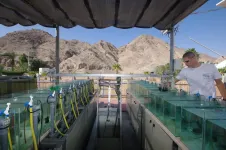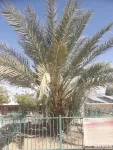(Press-News.org) When it comes to batteries, lithium-ion are the best we have as far as energy density and convenience.
For now.
The Washington University in St. Louis lab of Peng Bai, assistant professor in the Department of Energy, Environmental & Chemical Engineering in the McKelvey School of Engineering, has developed a stable sodium ion battery that is highly efficient, will be less expensive to make and is significantly smaller than a traditional lithium ion battery due to the elimination of a once-necessary feature.
"We've found that the minimal is maximum," Bai said. "No anode is the best anode."
The research was published May 3, 2021, in the journal Advanced Science.
A traditional lithium ion battery consists of a cathode and anode, both of which store lithium ions; a separator to keep the electrodes separated on either side; and an electrolyte -- the liquid through which the ions move. When lithium flows from the anode to the cathode, free electrons leave through the current collector to the device being powered while the lithium passes the separator to the cathode.
To charge, the process is reversed, and the lithium passes from the cathode, through the separator, to the anode.
The concept of replacing lithium with sodium and doing away with the anode isn't new.
"We used old chemistry," Bai said. "But the problem has been, with this well-known chemistry, no one ever showed this anode-free battery can have a reasonable lifetime. They always fail very quickly or have a very low capacity or require special processing of the current collector."
Anode-free batteries tend to be unstable, growing dendrites -- finger-like growths that can cause a battery to short or simply to degrade quickly. This conventionally has been attributed to the reactivity of the alkali metals involved, in this case, sodium.
In this newly designed battery, only a thin layer of copper foil was used on the anode side as the current collector, i.e., the battery has no active anode material. Instead of flowing to an anode where they sit until time to move back to the cathode, in the anode-free battery the ions are transformed into a metal. First, they plate themselves onto copper foil, then they dissolve away when it's time to return to the cathode.
"In our discovery, there are no dendrites, no finger-like structures," said Bingyuan Ma, the paper's first author and a doctoral student in Bai's lab. The deposit is smooth, with a metal luster. "This kind of growth mode has never been observed for this kind of alkali metal."
"Observing" is key. Bai has developed a unique, transparent capillary cell that offers a new way to look at batteries. Traditionally, when a battery fails, in order to determine what went wrong, a researcher can open it up and take a look. But that after-the-fact kind of observation has limited usefulness.
"All of the battery's instabilities accumulate during the working process," Bai said. "What really matters is instability during the dynamic process, and there's no method to characterize that." Watching Ma's anode-free capillary cell, "We could clearly see that if you don't have good quality control of your electrolyte, you'll see various instabilities," including the formation of dendrites, Bai said.
Essentially, it comes down to how much water is in the electrolyte.
Alkali metals react with water, so the research team brought the water content down. "We were hoping just to see a good performance," Bai said. Watching the battery in action, the researchers shortly saw shiny, smooth deposits of sodium. It's the smoothness of the material that eliminates morphological irregularities that can lead to the growth of dendrites.
"We went back to check the capillary cells and realized there was a longer drying process of the electrolyte," Bai said. Everyone talks about the water content in batteries, but, in previous research, the amount of water had often been relegated to simply a statistic that needed to be noted.
Bai and Ma realized that it was, in fact, the key.
"Water content must be lower than 10 parts-per-million," Bai said. With that realization, Ma was able to build not just a capillary cell, but a working battery that is similar in performance to a standard lithium-ion battery, but takes up much less space because of the lack of an anode.
"Check your cell phone. Your electric car. One quarter of the cost of such items comes from the battery," Bai said. Sodium batteries use a more common metal than lithium batteries; they have the same energy density as lithium batteries; and they are smaller and cheaper than lithium batteries, thanks to the elimination of the anode.
"We proved you can use the simplest setup to enable the best battery," Bai said.
INFORMATION:
Hydraulic fracturing to extract trapped fossil fuels can trigger earthquakes. Most are so small or far from homes and infrastructure that they may go unnoticed; others can rattle windows, sway light fixtures and jolt people from sleep; some have damaged buildings.
Stanford University geophysicists have simulated and mapped the risk of noticeable shaking and possible building damage from earthquakes caused by hydraulic fracturing at all potential fracking sites across the Eagle Ford shale formation in Texas, which has hosted some of the largest fracking-triggered earthquakes in the United States.
Published ...
ATLANTA--An influenza vaccine that is made of nanoparticles and administered through the nose enhances the body's immune response to influenza virus infection and offers broad protection against different viral strains, according to researchers in the Institute for Biomedical Sciences at Georgia State University.
Recurring seasonal flu epidemics and potential pandemics are among the most severe threats to public health. Current seasonal influenza vaccines induce strain-specific immunity and are less effective against mismatched strains. Broadly protective influenza vaccines are urgently needed.
Intranasal vaccines are a promising strategy for combatting ...
BOSTON -- For the first time, researchers have shown how Mullerian inhibiting substance (MIS), also known as anti-Mullerian hormone, a key reproductive hormone, suppresses follicle development and prevents ovulation in females. "Understanding the mechanism of follicle development by MIS opens the door to creating novel approaches to contraception, preserving the eggs of young girls undergoing chemotherapy, enhancing the success of fertility treatment, and potentially delaying menopause," says David Pépin, PhD, an associate molecular biologist in the Department of Surgery at Massachusetts General Hospital (MGH) and senior author ...
Even under the most optimistic scenarios, most of the coral reef ecosystems on our planet - whether in Australia, the Maldives or the Caribbean - will have disappeared or be in very bad shape by the end of this century. That's because global warming is pushing ocean temperatures above the limit that single-cell algae, which are corals' main allies, can withstand. These algae live inside coral tissue for protection and, in exchange, provide corals with essential nutrients produced through photosynthesis. Because the algae contain a variety of pigments and therefore give coral reefs their famous colors, if they are lost the corals turn white, which is known as coral bleaching. But in spite of the real threat caused by global warming, corals in the ...
Abu Dhabi, UAE, May 3, 2021: Researchers from NYU Abu Dhabi's Center for Genomics and Systems Biology have successfully sequenced the genome of previously extinct date palm varieties that lived more than 2,000 years ago. They did so using date palm seeds that were recovered from archaeological sites in the southern Levant region and radiocarbon-dated from the 4th century BCE to the 2nd century CE. The seeds were germinated to yield viable, new plants. The researchers conducted whole genome sequencing of these germinated ancient samples and used this genome data to examine the genetics of these previously extinct Judean date palms. This study marks the first time researchers have sequenced the genomes of plants ...
First-of-its-kind model replicates human alveolar lung tissue
Allows researchers to study effects of COVID-19 on cell growth and development
Provides insight as to how various drugs impact viral spread
Globally, lung failure is one of the leading causes of death. Many conditions can affect and damage the lungs, including asthma, chronic obstructive pulmonary disease, influenza, pneumonia, and, most recently, COVID-19. To better understand respiratory diseases and develop new drugs faster, investigators from Brigham and Women's Hospital designed a ...
CHAMPAIGN, Ill. --A new study found overlooked tsunami hazards related to undersea, near-shore strike-slip faults, especially for coastal cities adjacent to faults that traverse inland bays. Several areas around the world may fall into this category, including the San Francisco Bay area, Izmit Bay in Turkey and the Gulf of Al-Aqaba in Egypt.
The study led by University of Illinois Urbana-Champaign civil and environmental engineering professor Ahmed Elbanna and professor Ares Rosakis of the California Institute of Technology used the Blue Waters supercomputer at the National Center for Supercomputing Applications to model ...
ALBUQUERQUE, N.M. -- Sometime between 50,000 and 70,000 years ago, prehistoric humans took their first steps into Sahul, an ancient landmass made up of modern Australia, New Guinea and Tasmania. But nobody knows which way they went after that.
"One of the really big unanswered questions of prehistory is how Australia was populated in the distant past. Scholars have debated it for at least 150 years," said Sandia National Laboratories archaeologist and remote sensing scientist Devin White.
Now, an international team of scientists using a Sandia supercomputer in the largest reconstruction ...
Palo Alto, CA--New work from a Stanford University-led team of researchers including Carnegie's Arthur Grossman and Tingting Xiang unravels a longstanding mystery about the relationship between form and function in the genetic material of a diverse group of algae called dinoflagellates.
Their findings, published in Nature Genetics, have implications for understanding genomic organizational principles of all organisms.
Dinoflagellates include more than 2,000 species of marine and freshwater plankton, many of which are photosynthetic, and some of which also ingest other organisms ...
MADISON -- From radio to television to the internet, telecommunications transmissions are simply information carried on light waves and converted to electrical signals.
Silicon-based fiber optics are currently the best structures for high-speed, long distance transmissions, but graphene -- an all-carbon, ultra-thin and adaptable material -- could improve performance even more.
In a study published April 16 in ACS Photonics, University of Wisconsin-Madison researchers fabricated graphene into the smallest ribbon structures to date using a method that makes scaling-up simple. In tests with these tiny ribbons, ...



